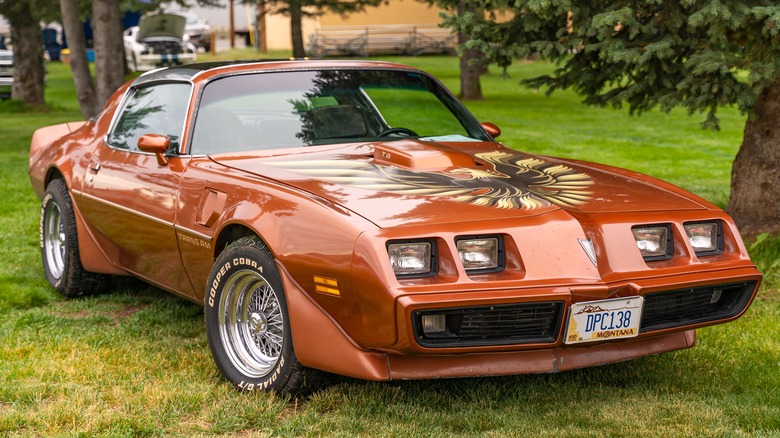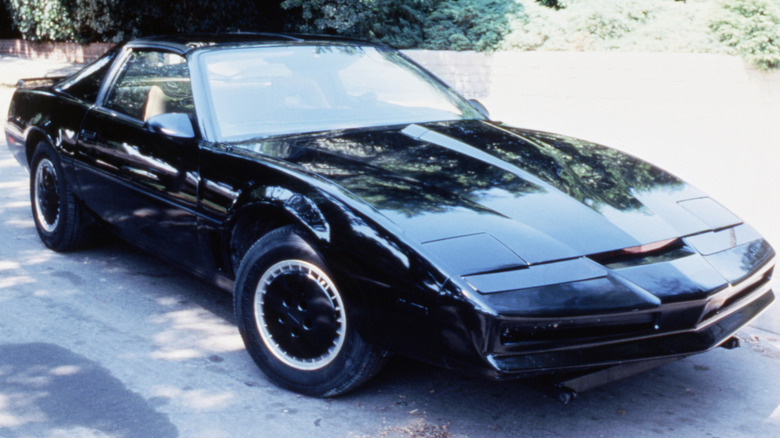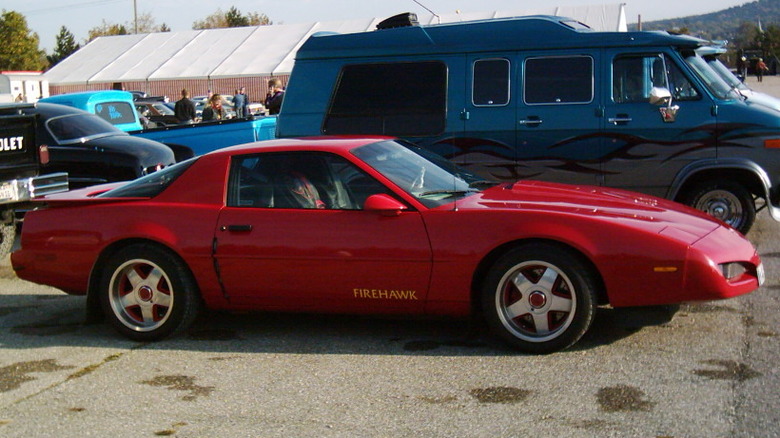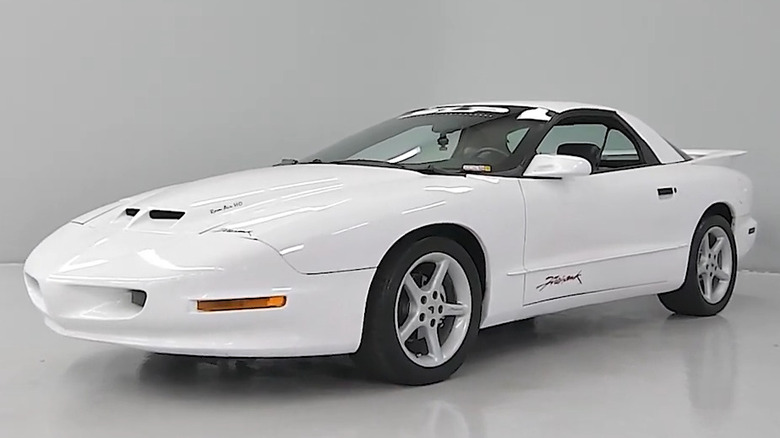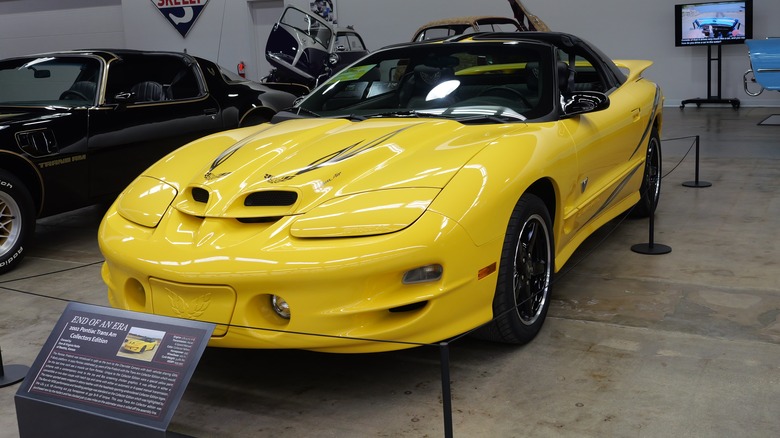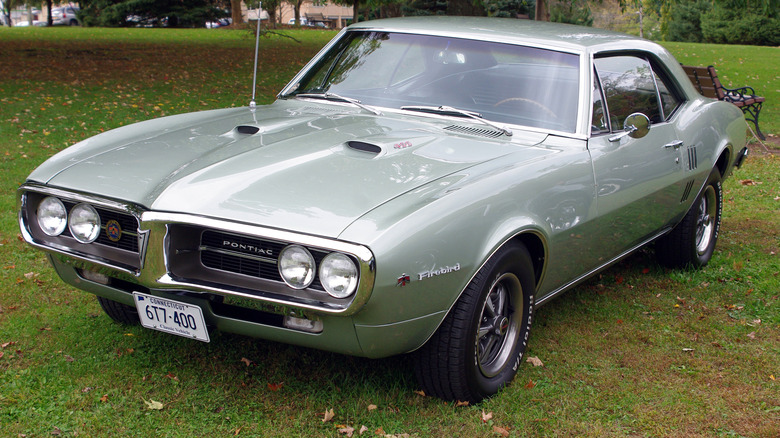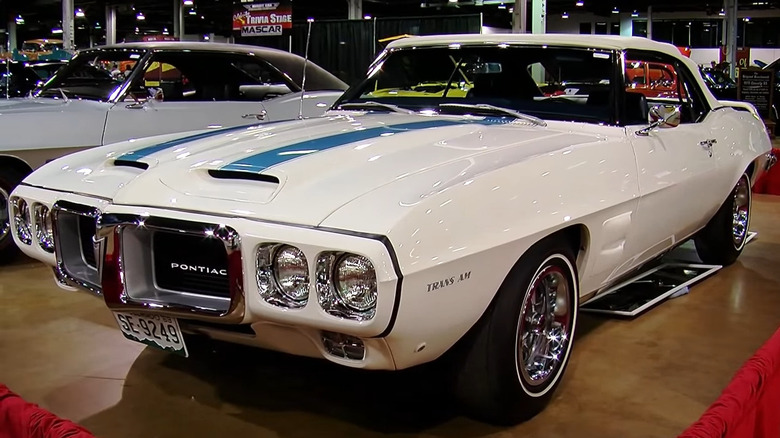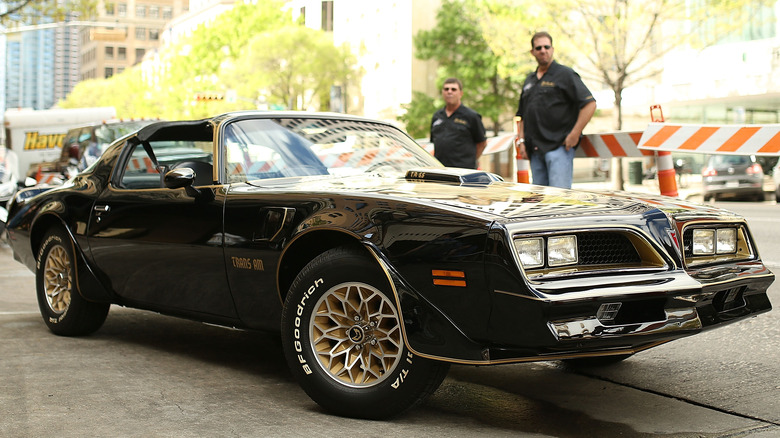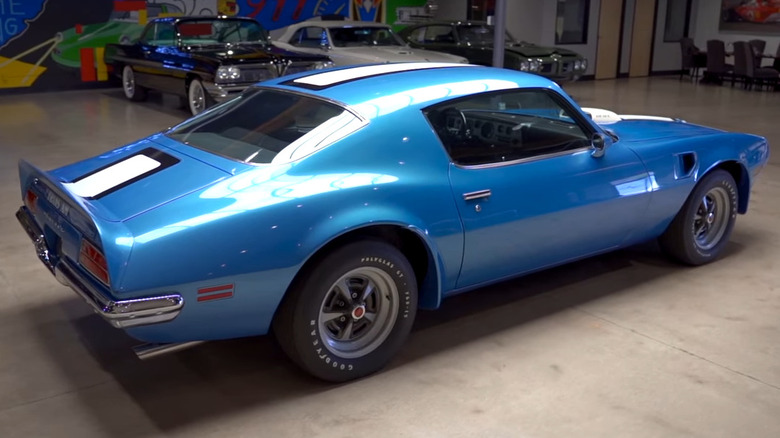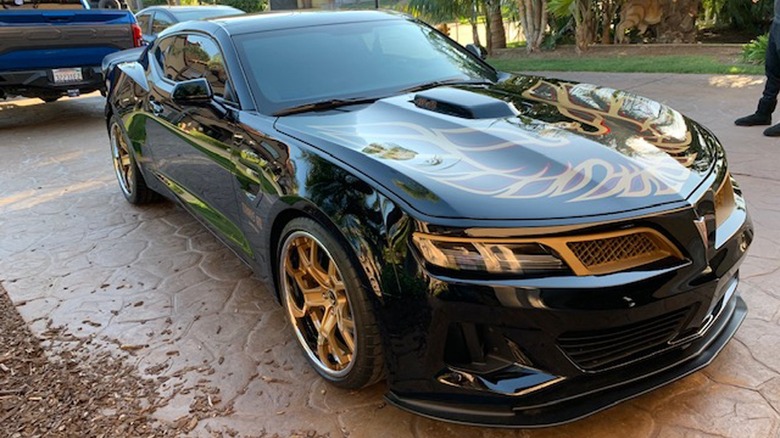Every Generation Pontiac Firebird Ranked Worst To Best
The Pontiac Firebird is an enigma among American pony cars, something wholly unique while still being derivative. It was born to compete with the Ford Mustang indirectly and directly compete with the Mercury Cougar, but it ended up mostly butting heads with its stablemate, the Chevrolet Camaro. General Motors limited the potential of the Firebird from the off, ensuring the Camaro had all the perks and design advantages. But the Firebird, with some help from Hollywood, persevered and found its way into millions of Americans' hearts.
The Firebird was relatively short-lived but popular as a sports car and racer, spanning four generations and 35 years of production from 1967–2002. And while plenty of that success was owed to the Firebird's sub-brand, the Trans Am, the main badge was also strong and innovative when GM allowed it to be. Given the short history of the 'bird, we're going to be taking things a little differently with this ranking. We're going to rank all four generations, feature a few favorites from each of those generations, and update you on one company's efforts to keep the legacy of Pontiac's pony car alive.
4. Third Generation, 1982–1992
The third generation of Pontiac Firebird, which ran from 1982 to 1992, was notable for a distinct lack of power — a lower floor if you will. The elimination of Pontiac's V8 engine from its base Firebird by General Motors in 1981 led to some creative solutions but an overall drop in performance for much of the 10-year period. The old saying is that "necessity is the mother of invention," a phrase Pontiac's designers took to heart when figuring out how to work around limitations introduced by a more environmentally-conscious country and the aforementioned dropping of big, beefy V8 engines from the Firebird line.
A complete redesign was called for and delivered in 1982. The Firebird's new body shape was born in a wind tunnel, providing better aerodynamics than ever before. Five hundred pounds of weight was shed in the new design. The windshield was sloped to a whopping 72 degrees, and the pop-up headlights were in line with some of the finest in '80s design style. And a 2.5-liter inline six-cylinder engine was offered, which got a gas-sipping 32 highway miles per gallon at 88 horsepower.
Fortunately for muscle car aficionados, V8s were still available, but limitations put upon Pontiac — and all automakers — by governmental regulations meant a drop in overall power. A 5.0-liter V8 was the largest the manufacturer could offer, and it wasn't until late in the third generation that engine output began to fall in line with some of the previous generations' offerings.
Third-gen highlights
While the third generation of Firebird is lowest on SlashGear's ranking, that doesn't mean there was a lack of cool cars that Pontiac produced in those 10 years.
Arguably, the most famous third-gen is the 1982 Pontiac Firebird Trans Am. A modified version of that Trans-Am, known as KITT, was featured in David Hasselhoff's beloved "Knight Rider" television series. Featured in the previous section, that car was an AI-powered supercomputer with a turbojet engine, but sadly a feature-perfect version of the TV car, with the voice of Mr. Feeney from "Boy Meets World," a Cylon-like red grill light, and dozens of interior lights and controls, was never mass produced.
In 1991, a company called Street Legal Performance (SLP), based out of New Jersey, began collaborating with Pontiac to create the above-pictured SLP Firehawk, similar to Carroll Shelby's famous Cobra line of Ford Mustangs. The Firehawk was essentially a modified Firebird Formula; however, Firehawks were each custom-made to order, and only 25 were made in the first production year. It was a beast of a vehicle, with a modified L98 350 V8 that churned out 360 horsepower. Other optional mods and upgrades included a roll bar, Recaro seats, a Chevrolet Corvette six-speed ZF manual transmission, and a fuel cell.
[Featured image by Tobias ToMar Maier via Wikimedia Commons | Cropped and scaled | CC BY-SA 3.0]
3. Fourth Generation, 1993–2002
The end of the line for the Firebird, the fourth generation, saw a complete redesign of the vehicle once again. More aerodynamic and sleek-looking, Pontiac saw some of the lost power from the second and third generations of Firebird restored with the inclusion of the LS1 engine, a 5.7-liter V8 that could output 305–330 horsepower. The Trans Am and SLP Firehawk performance models continued alongside the base Firebird until the end of the road. By 1994, the familiar coupe and T-top options saw a third option reintroduced — the resurrection of the Firebird Convertible.
The Firebird and its cousin, the Chevrolet Camaro, were dropped from GM's lineup after 2002 after a decline in sales. While the Camaro would see a revival in 2010, Pontiac as a brand was already dead and gone, making a resurrection of the screaming chicken impossible at the time.
As the later entries on our list will exhibit, the Firebird's run would produce some unforgettable vehicles that are considered iconic to this day. So, while the fourth generation marked the end of the road for Pontiac's pony car, we've still got a long way to go in our generational recap.
Fourth-gen highlights
In the middle of the final generation of Firebirds, SLP saw an opportunity to create something unique with their high-performance Firehawks. The company acquired some LT4 V8 engines, known for their inclusion in the 1996 Corvette Grand Sport, and while many of those engines saw their way into the 30th anniversary Camaro, SLP installed 29 of them into the 1997 SLP Firehawks (featured in the photo in the previous section). Rarity normally makes for a fine auction price, but the high-powered performance 'bird has gone for between $9,500 and $20,000.
The last of the last generation, the 2002 Pontiac Firebird — specifically, the Trans Am WS6 Collector Edition — was a great note for the celebrated 'bird to go out on. Pictured above, around 2400 CEs were produced for the final model year of the Firebird, and all of them were painted in glorious Sunfire Yellow. The Ram Air package, coupled with a 5.7-liter V8, produced a respectable 325 horses, and the classic pop-up headlights topped a lengthy list of features. The Firebird logo is everywhere on this Collector's Edition, from the hood, trunk, and doors to the embossed headrests.
2. First Generation, 1967–1969
General Motors created the Pontiac Firebird and Chevrolet Camaro in 1966 (and released them in '67) to compete directly with Ford's Mustang in the pony car market. Unfortunately, the company almost immediately began to put Pontiac's offering at a disadvantage to Chevy's. While both cars were built on GM's F-body platform and shared many similarities and a "Coke-bottle" body style, GM limited its largest and most powerful engine options to the Camaro.
While the size of the Firebird increased by 1969 — the end of its short three-year first generation — it was the introduction of the Ram Air engine package in 1967 and the Trans Am option package in 1969 that really set the Pontiac pony car apart. The Ram Air package started by making the Firebird's decorative hood scoops functional and was later improved upon with improvements to its cylinder heads, camshaft, and intake manifold, among others. And the Trans Am would go on to become nearly as legendary as the Firebird itself.
First-gen highlights
Even though the Firebird's first generation spanned only a few years, a number of rare standouts still exist. Arguably, the most beloved first-generation Pontiac Firebird is the original 1967, featured in the previous section. The two-door coupe (or convertible), while not selling as well as its competitors in the pony car class like the Chevy Camaro, Mercury Cougar, and Ford Mustang, still performed well enough to establish the Firebird as a competitor for years to come.
Pontiac rolled over 82,000 Firebirds off its line at the Lordstown, Ohio, assembly plant in 1967. Four different engines were offered, from a 3.6-liter inline six that produced 165 horsepower and 216 pound-foot of torque to a beefy 6.6-liter Ram Air V8 (pictured above) that generated 335 horses and 410 pound-foot of torque. Sixty-five of those Ram Air Firebirds were produced, making them rare but somehow not the rarest of the first-generation Firebirds.
That accolade is reserved for the "holy grail" of the first-gen, the 1969 Pontiac Firebird Trans Am convertible (above). First-generation convertibles were available but were largely outsold by the coupe option at a nearly four-to-one rate. Of the 697 Firebird Trans Ams built that first production year, only eight were convertibles. These highly sought-after cars — one of which is featured in our previous section — all included the Ram Air III motor and auctioneer Hemmings says the market value for these vehicles is between $1.5–2 million.
1. Second Generation, 1970–1981
The longest-lasting generation of Firebirds was the second and featured one of the most iconic Firebirds in the model's history. Unfortunately, the combination of the 1973 oil crisis, increased fuel prices and insurance rates, and more stringent emissions and safety standards meant the Firebird had to undergo significant changes during its second generation.
The introduction of the second generation saw a longer, lower, heavier Firebird. Convertible tops were no longer an option, despite four distinct trims now being offered — the base Firebird, Esprit, Formula 400, and the popular Trans Am. In 1975, a body redesign added a wraparound rear window and updated front end. But perhaps more significant was the beginning of the issues that would plague much of the back half of the second-gen and the beginning of the third.
Emissions limits and the implementation of EGR systems delayed the new LS2 SD455 engine option from hitting the market until late 1973 and increasing environmental limitations led to the elimination of several V8 options later in the generation. Vehicle weight increased the next year due to safer telescoping bumper requirements. The addition of catalytic converters and emissions limits meant smaller engines and less impressive transmissions were used — by 1980, the biggest V8 still available for the Firebird was a 5.0-liter.
Even with these new requirements, Pontiac managed to make the Firebird an essential piece of Americana. The release of a Burt Reynolds classic movie helped the Firebird Trans Am nearly double production from 1977 to 1979.
Second-gen highlights
The second generation of Pontiac Firebird had a few milestones that forever entered the muscle car into the American zeitgeist. One of the first was the introduction of the iconic "hood bird" in 1973. Lovingly referred to as the "screaming chicken," the Trans Ams's hood-covering, fire-breathing Firebird was an option that ran buyers an extra fifty bucks, but it also guaranteed onlookers knew exactly what they were looking at.
One of the most iconic vehicles to sport the hood bird was the 1977 Pontiac Firebird Trans Am (previous section). Driven by Burt Reynolds in the film "Smokey and the Bandit," the black and gold muscle car (and its driver) oozed cool. Pontiac provided four 1976 Trans Ams modified to look like the upcoming '77, and all four got destroyed during filming. A testament to how incredibly popular the film became, Reynolds' replica — not a film-used vehicle, mind you — sold at auction for nearly $500,000 in 2022.
While some collectors sought a Hollywood icon, others looked for a second-generation Firebird with something more substantial under the hood. For those fans, the rare 1970 Pontiac Firebird Trans Am Ram Air IV (above) would like a word. Of the nearly 3200 Trans Ams Pontiac made in 1970, a scant 88 Ram Air IVs were produced that year. One amazing restoration was sold at auction early in 2023 for $154,000 — not bad for a Trans Am that wasn't owned by an iconic movie star.
Current Generation
We'll wrap things up with the "current" generation of Firebird. When General Motors sold the trademarks for Trans Am to Trans Am Worldwide in 2012, it managed to keep an American tradition alive through some innovative means. Florida-based Trans Am Worldwide is a custom automaker, and it uses chassis from modern Chevrolet Camaros to recreate the spiritual cousin of the old Camaro: the Firebird Trans Am.
Features like glass T-tops, a shaker hood and scoop, and the glorious screaming chicken hood decal all contribute to this new version of a classic car getting the feel of the original. But 2017's Trans Am 455 Super Duty (above), built off a sixth-generation Camaro chassis, shows the custom builders' dedication to evolving the 'bird, with a 1,000 horsepower performance package available along with carbon fiber body panels, race wheels, and optional Brembo brakes. Among other custom jobs, the company also made 77 Bandit Edition Trans Ams, an homage to the iconic 1977 Firebird Trans Am promoted by Burt Reynolds himself.
While it's not fair to compare these current versions of the Firebird or Trans Am to the originals, it is worth acknowledging the enthusiasts putting in the work to keep the legacy of the majestic Screaming Chicken, the Pontiac Firebird, alive.
